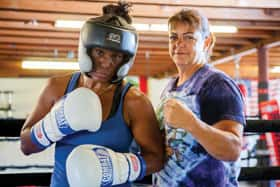When faced with challenges in business and in life, it helps to have a positive attitude and the confidence to address tough situations head-on. Across the North Bay, many professionals are building these skills through combat-based exercise, including fencing, boxing and various martial arts. Participating in any sport can have a positive effect—the discipline of training, following the leadership of coaches and captains, and learning to lose without giving up are all important factors in long-term happiness and success. So what makes these pursuits especially appealing? NorthBay biz checked in with a handful of coaches and trainers who focus on these age-old practices to find out why their popularity is growing.
 En Garde!
En Garde!
A major hurdle for those teaching fencing is getting people to realize that it’s not just dueling medieval knights in shining armor—it’s actually something that anyone, at any age, can learn. In a study of injuries that occurred in the 2008 Summer Olympics and 2010 Winter Olympics, where the injury prevented an athlete from competing or training, fencing had one of the lowest injury rates, ranking below even table tennis and badminton. Only five summer Olympic sports had lower injury rates than fencing in this study, completed by Lars Engebretsen of the Oslo Sports Trauma Research Center—diving, synchronized swimming, rowing, kayaking and sailing.
“A lot of adults I work with do this because it’s not as punishing, in terms of the toll it takes on one’s body,” says Jim Liebich, owner of Santa Rosa-based En Garde Fencing, who came into the sport himself as an adult. “There are many sports that everyone can do, but they get a lot harder on the body as you get older. Fencing has a low rate of injury, but you can still get very intense with it and get a fantastic workout. You’re really sweating when you’re fencing.”
In addition to the short bursts of high intensity that the sport requires, a lot of students are drawn to the mental workout one gains as well. Fencing, as with most combat sports, is tactical and strategic.
“Besides getting an incredible cardiovascular workout, one of the intangibles is really this,” says Bill Bailey, a director of sales for a software company who started fencing about six years ago (after his three sons started taking classes) and who now acts as an assistant coach at En Garde: “When you’re learning something new, you’re activating parts of your brain that may have been dormant for a while. Because you’re learning, analyzing, thinking and strategizing in between touches of a bout which last seconds, your brain is much more active.
“So when you get into your work environment or other situation, you’re now thinking, looking and acting differently because you’re training yourself to do this on the fencing strip. I find that these skills spill over into my work and home environment.”
Bringing up the past
For those who prefer an intellectual component to their workouts, Santa Rosa-based En Garde Fencing offers historical European martial arts classes. The classes involve studying old texts, written by the greatest sword masters in history, using replicas of weapons from centuries ago and following the rules from that time period. Some classes feature the heavy saber, a calvary weapon used in battlefields and duels in the 1800s, and use daggers and rapiers, dueling weapons from the 1600s.
These classes tend to reach a different demographic than those in the standard Olympic-style fencing classes. “Someone who wants to do the martial arts style [historical fencing] is most often someone fascinated by the historical weapons and the history of western martial arts,” says Liebich. “In a sense, it’s more of an intellectual pursuit. It’s still very athletic—it’s a good workout—but there’s also an aspect that really appeals to people who love history.”
Liebich has seen fencing’s overall popularity grow over the past decade, but historical fencing is still too new to really gauge. “It’s very new, but when people see it, they’re often fascinated,” he says. “The thing about fencing, in general, is that people think it sounds neat and looks cool, but they have a hard time imagining themselves doing it because it’s not familiar. Fencing almost has a ‘spectator’ air to it. But even so, more people are starting to realize that it’s not out of their reach or just some thing that other people do. It’s something that they can do, and the only thing that’s holding them back is themselves.”
 Living the black belt
Living the black belt
For Phil Des Rosiers, owner of The Dojo in San Anselmo, whose mission is to empower people’s lives with the positive benefits of a unique blend of old traditional and modern day martial arts, the reason to train comes down to integrity.
“We have a saying: ‘What is a black belt? It’s a white belt that never quits,’” says Des Rosiers, who credits much of his “black belt mentality” to his previous mentor, Jeff Dix. “If you’re a small business owner and you’re looking for a different mindset, come to me, because you’re going to be held accountable for your actions. I don’t do excuses. I’m like a life coach. If you have issues in your life like not getting things done and procrastinating, then you’re not going to get a black belt. To get a black belt you have to focus, you have to train, you have to be present and you have to do the work.”
When adults begin the training to earn a black belt in a martial art, they benefit on many different levels. They learn self-defense techniques and can feel empowered, they get physically fit and gain mental dexterity and physical agility through bilateral movement. In addition, simply the act of engaging in a sport like this can help bring order to other areas of their lives.
“The road to black belt is a group of small goals—yellow belt, orange belt, purple belt, blue belt, and so on, says Des Rosiers. “You achieve a small goal with a large goal in mind. That can transfer to every aspect of your life. If you want to make a change, then figure out the path and approach it just like you would a black belt.”
Something for everyone
There’s a plethora of combat and defensive sport options to choose from in the North Bay, with a class or methodology to suit just about anyone at any age. From kenpo to Brazilian jiu jitsu, muay Thai, judo, kickboxing, or hybrid versions of any of these (and more) most schools offer free introduction classes for individuals trying to find the right fit. While some facilities pride themselves on training in traditional techniques, others have altered their methods to appeal to various student demographics.
At Napa-based Main Street Martial Arts, whose adult program incorporates a vast variety of styles to create an effective mixed martial art they call their “integrated fighting system,” Adam Wamsley recently created “Napa Fight Sports,” a combination of Brazilian jiu jitsu with American wrestling and kickboxing that creates a very effective, competitive art and sport that, above all, stresses functionality.
“A functional workout works your body in a way that you might need it,” explains Wamsley, a competitive Brazilian jiu jitsu and MMA (mixed martial arts) athlete. “I focus on your body functioning properly, not just living heavy weights or running on a treadmill, but doing things that challenge your body in a practical way. This can be useful for things that you might have to do at work involving strength and balance. Fighting is a real function of your body, and it translates to almost everything.”
 Leave it in the ring
Leave it in the ring
Besides getting an excellent physical and mental workout, students of combat sports also say stress release keeps them in the game. For Suzie Howard, owner of Novato Boxing Club, martial arts became a form of anger management after the death of her husband at a young age. She started martial arts before progressing to becoming a professional kick boxer, and eventually a professional boxer. Howard always had a vision of starting a boxing club to help children; 20 years ago it became a reality, and she now runs the only boxing club in Marin County.
From adult professionals who need to decompress to children who’ve been bullied and need the empowerment that boxing offers, Howard has seen a wide range of individuals choose the sport for stress relief.
“I get people from all different backgrounds,” says Howard. “I’ll get a person who’s had a hard day at work and needs to relieve some stress and I’ll get kids or adults who’ve been traumatized or physically abused. People like that want to get empowered and build confidence.”
These skills can translate to every other aspect of one’s life, as Marquita Lee, a professional boxer who fell in love with the competitiveness of the sport 10 years ago, can attest.
“I think [boxing] brings a better mental focus in my work environment,” says Lee, who also works in the radiology department at Novato Community Hospital. “I’m able to understand and deal with people better. I have more patience and it calms me down.”
Lee initially started boxing with no prior athletic experience—she simply wanted to choose an exercise to help her lose some weight—which points to another benefit of combat sports: no prior experience or fitness level is needed to begin. Most start with learning a set of basic moves and drills that are repeated over and over again to achieve fluency and efficiency.
“Start anywhere,” says Wamsley. “ Most of these places, even though they may be intimidating, like some of these MMA or fight gyms, have beginner programs. It’s not like you’ll go in there and get beat up.”
Instead of worrying about what level of fitness you are now, it is more important to be willing to make mistakes and check your ego at the door.
“It’s exceedingly humbling to be beat by a 13 or 14 year old if my head isn’t in the game and I make a mistake that they’re smart enough to catch. Simply having the willingness to be coached can be a challenge. I have to set aside ‘I’m a Dad, I’m a director of sales, I’m responsible for 98 percent of the revenue of this organization.’ I’m in charge of a lot of things, but I put that aside to be coached. At our age, that’s a decision,” says Bailey of his fencing experiences.
As adults we’re trained to think that mistakes are negative. If we make a mistake at work, it can cost money, time and resources so they’re to be avoided at all costs. But in the ring, dojo, or on the fencing strip, it’s important to make mistakes. That’s how we learn. As Liebich articulates, “It’s not about what you can do, it’s about what you want to become.”
On the Ball
Squash, a racket sport played by two or four players in a four-walled court with a small, hollow rubber ball, was first introduced in England in the early 1800s. By 1884, the first squash court appeared in North America and by 1904, the earliest national association of squash in the world was formed as the United States Squash Rackets Association, now known as U.S. Squash.
While racquetball courts seem to be the more ubiquitous option at gyms in this area, if worldwide statistics are an indicator, then squash is poised to experience tremendous growth. Worldwide, racquetball is an official sport in eight countries with an estimated 5.6 million players, whereas, according to the World Squash Federation, there are almost 50,000 squash courts in 188 countries and territories, with an estimated 20 million players (as of June 2009). Today, The United States has the fastest growing squash participation.
A lot of players are attracted to the sport both for its excellent cardiovascular workout as well as the mental challenge and focus it requires. In one hour of squash, a player can burn from 600 to 1,000 calories in this full body workout. In 2003, Forbes magazine rated squash as the number one healthiest sport to play.
“Squash is like playing chess with a racket,” says Erick Chacon, squash director for Bay Club Marin, which boasts the only squash courts in Marin County and offers a full range of squash programs for players of all ages and abilities, an online ladder service and a playing-partner matching program. “It’s very mental. Google in Switzerland has squash courts in its headquarters. Squash keeps the mind sharp for everything. It works your reflexes and focus.”
An added benefit is the social environment, for both fun and networking purposes. “It’s a very good social environment,” says Chacon. “It not only offers a physical and mental benefit, but there’s also a benefit network-wise as well. The people you’re going to come across playing squash are CEOs of various companies—very successful people, real doers—those are the people who play squash in the United States.”
 Fencing for All
Fencing for All
To help promote fencing as well as other martial arts disciplines available in Sonoma County, Jim Liebich of En Garde Fencing is forming a martial arts trade organization and will be putting on a martial arts family expo. In addition, he hopes to create an international historical fencing tournament, possibly as early as spring 2017, which will host competitions in heavy saber, rapier and long sword.



